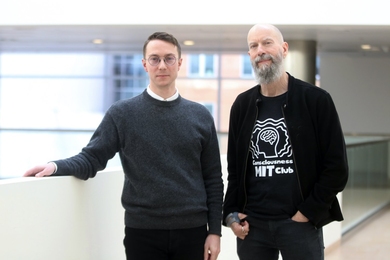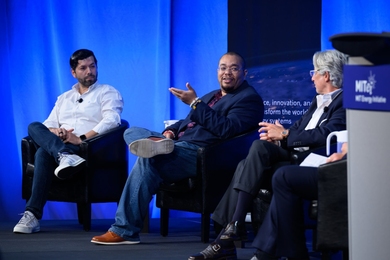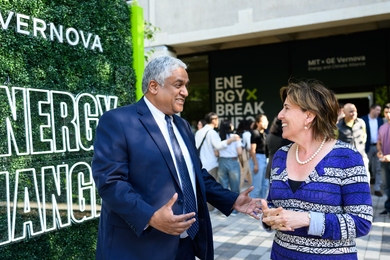President Charles M. Vest opened the April 15 faculty meeting with a report from his office summarizing administration responses to the "Sense of the Faculty" resolution on undergraduate life, which was approved by the faculty in November 1997.
The Sense of the Faculty resolution addressed aspects of community life, including the residential system, freshman orientation and student-faculty ties, with an eye to improving or enhancing the student experience at MIT.
"These are big issues," Dr. Vest said. "It takes a long time to make shifts in the culture on campus -- and the changes we want will require the participation of many: faculty, students and staff."
Noting the faculty's "particular emphasis on enhancing the residential experience" of MIT undergraduates, President Vest responded first to the faculty's request for a "comprehensive, deliberate examination of its residential system, including the suitability of undergraduate residences as freshmen housing.
"A faculty-staff group on orientation and residence for fall 1998, headed by Professor Kim Vandiver, reviewed the question of whether MIT could or should house all freshmen on campus beginning this coming fall��������������������������� and concluded that such a move would not be feasible. While freshmen will not be required to live on campus, we will accommodate all those who wish to do so.
"We are beginning a pilot program this fall with a small number of FSILGs [fraternities, sororities and independent living groups] who have expressed an interest in having resident advisors in the houses," President Vest said. "The Dean's Office is interested in talking to any faculty member who is interested in being a house associate, whether resident or not.
"Under the auspices of the Academic Council, Associate Provost Phillip Clay is currently heading a group to develop long-term principles and goals for the entire undergraduate residential experience," President Vest said, adding that a report from this group is expected in May, 1998.
In response to the faculty suggestions about the "newly promised undergraduate dormitory," President Vest announced, "The new dorm is expected to be ready for occupancy within three years��������������������������� During the summer, we will engage professional planning help to develop a program document��������������������������� [and begin] architect selection in the fall.
"In addition, we will be developing specific mechanisms for ongoing student and faculty input in the planning process. This term, for example, an architectural design seminar led by Professor Jan Wampler has used the project for their studio and has responded to the challenge with enthusiasm.
"Our goal is to make all of our student housing responsive to the students' wishes for stronger community," he concluded.
President Vest responded at length to the sense of the faculty on freshman orientation, which called for "a proper orientation to the Institute's academic environment; a sense of belonging to the larger MIT community; greater opportunity for interaction with faculty and each other; and the ability to make a calm, informed choice of living group."
In particular, Dr. Vest noted he had received a "set of principles for introducing new students, especially freshmen, to the campus," from the Working Group on Orientation and Residence for Fall 1998. "These suggestions included expanding faculty/student interaction during the summer and orientation, restrictions on summer contacts from FSILGs, holding important orientation activities before rush, expanding on current academic activities and developing new events to stimulate intellectual excitement, and sponsoring workshops on alcohol/drug awareness, personal skills and support services.
"Subsequently, the orientation program for next fall has been revised to shift the focus away from residence selection and toward an introduction to academic life and community building for the entering class as a whole.
"We are also revising the process of residence selection so that it is better informed, less stressful, more extensive and better integrated with orientation to the institution as a whole," he said.
"In the meantime, our incoming freshmen and their families are getting information earlier. For example, at prefrosh weekend on April 3-5, we had for the first time a mini-residence midway and an orientation for parents regarding the support services available to students, housing, and so forth," Dr. Vest said.
Finally, in responding to the faculty's call for new initiatives to strengthen student-faculty ties and enhance the student experience, he said, "The resolution's call for such new initiatives -- and the funding to support them -- is a major challenge to the faculty as well as the administration."
The MIT administration has, he said, "made a start: we are asking faculty members to volunteer to make a welcoming call to at least one incoming student over the summer. I have volunteered to make some calls, because we know, from experience here and elsewhere, that this early contact with faculty members makes a big difference."
In addition, various funding commitments have also been made, including $300,000 from the Provost's Office "to enhance student activities on campus;" a $1,500 scholarly allowance to each faculty member who offers a Freshman Advising Seminar, beginning next fall; and a significant increase in the budget for Orientation itself.
President Vest concluded his responses to the Sense of the Faculty resolution with a challenge to all faculty members.
"Really significant change in this area, however, must involve the ideas and energies of the faculty. And we will look to you for leadership in this area," he said.
President Vest closed with a brief comment about the role of alcohol in Institute life, underscoring the administration's commitment to "helping students succeed in [their leadership role of] reducing binge drinking and establishing a richer social life on campus" (see the April 15 issue of MIT Tech Talk for a report on discussion and measures taken with regard to alcohol on campus).
A version of this article appeared in MIT Tech Talk on April 29, 1998.





